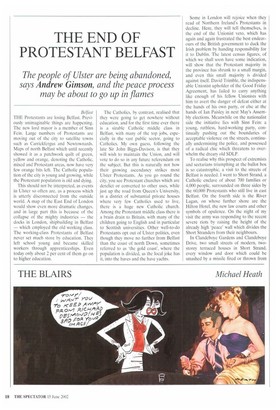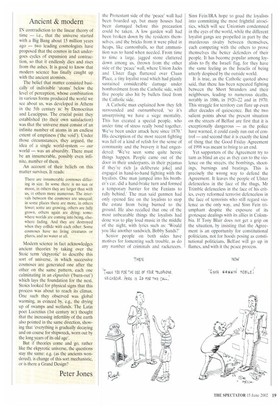THE END OF PROTESTANT BELFAST
The people of Ulster are being abandoned,
says Andrew Gimson, and the peace process
may be about to go up in flames
Belfast THE Protestants are losing Belfast. Previously unimaginable things are happening. The new lord mayor is a member of Sinn Fein. Large numbers of Protestants are moving out of the city to satellite towns such as Carrickfergus and Newtownards. Maps of north Belfast which until recently showed it as a patchwork quilt of green, yellow and orange, denoting the Catholic, mixed and Protestant areas, now have very few orange bits left. The Catholic population of the city is young and growing, while the Protestant population is old and dying.
This should not be interpreted, as events in Ulster so often are, as a process which is utterly disconnected from the outside world. A map of the East End of London would show even more dramatic changes, and in large part this is because of the collapse of the mighty industries — the docks in London, shipbuilding in Belfast — which employed the old working class. The working-class Protestants of Belfast never set much store by education. They left school young and became skilled workers through apprenticeships. Even today only about 2 per cent of them go on to higher education. The Catholics, by contrast, realised that they were going to get nowhere without education, and for the first time ever there is a sizable Catholic middle class in Belfast, with many of the top jobs, especially in the vast public sector, going to Catholics. My own guess, following the late Sir John Biggs-Davison, is that they will wish to maintain the Union, and will vote to do so in any future referendum on the subject. But this is naturally not how their growing ascendancy strikes most Ulster Protestants. As you go round the city, you see Protestant churches which are derelict or converted to other uses, while just up the road from Queen's University, in a district of substantial private houses where very few Catholics used to live, there is a huge new Catholic church. Among the Protestant middle class there is a brain drain to Britain, with many of the children going to English and in particular to Scottish universities. Other well-to-do Protestants opt out of Ulster politics, even though they move no further from Belfast than the coast of north Down, sometimes referred to as the gold coast', where the population is divided, as the local joke has it, into the haves and the have yachts. Some in London will rejoice when they read of Northern Ireland's Protestants in decline. Here, they will tell themselves, is the end of the Unionist veto, which has again and again frustrated the best endeavours of the British government to duck the Irish problem by handing responsibility for it to Dublin. The latest census figures, of which we shall soon have some indication, will show that the Protestant majority in the province has shrunk to a small margin, and even this small majority is divided against itself. David Trimble, the indispensable Unionist upholder of the Good Friday Agreement, has failed to carry anything like enough of his fellow Unionists with him to avert the danger of defeat either at the hands of his own party, or else at the hands of Ian Paisley in next May's Assembly elections. Meanwhile on the nationalist side the initiative lies with Sinn Fein: a young, ruthless, hard-working party, continually pushing out the boundaries of acceptable violence on the streets, continually undermining the police, and possessed of a radical chic which threatens to overwhelm the dreary old SDLP.
To realise why this prospect of extremists and sectarians triumphing at the ballot box is so catastrophic, a visit to the streets of Belfast is needed. I went to Short Strand, a Catholic enclave of about 700 families or 4,000 people, surrounded on three sides by the 60,000 Protestants who still live in east Belfast. On the fourth side is the River Lagan, on whose further shore are the Hilton Hotel, the new law courts and other symbols of opulence. On the night of my visit the army was responding to the recent severe riots by raising the height of the already high 'peace' wall which divides the Short Stranders from their neighbours.
In Clandeboye Gardens and Clandeboye Drive, two small streets of modern, twostorey terraced houses in Short Strand, every window and door which could be smashed by a missile fired or thrown from the Protestant side of the 'peace' wall had been boarded up, but many houses had been damaged before this precaution could be taken. A low garden wall had been broken down by the residents themselves, and the bricks from it were piled in heaps, like cannonballs, so that ammunition was to hand when needed. From time to time a large. jagged stone clattered down among us, thrown from the other side of the 'peace wall, where Union Jacks and Ulster flags fluttered over Cluan Place, a tiny loyalist road which had plainly sustained considerable damage under bombardment from the Catholic side, with five people also hit by bullets fired from the Catholic side.
A Catholic man explained how they felt surrounded and outnumbered, 'so it's unsurprising we have a siege mentality. This has created a special people, who under time of stress really bond together. We've been under attack here since 1870.' His description of the most recent fighting was full of a kind of relish for the sense of community and the bravery it had engendered: 'We've seen some quite heroic things happen. People came out of the door in their underpants, in their pyjamas if they're rich [a deliberate joke] and engaged in hand-to-hand fighting with the loyalists. One man jumped into his brother's car. did a hand-brake turn and formed a temporary barrier for the Fenians to rally behind.' The man said gunmen had only opened fire on the loyalists to stop the estate from being burned to the ground. He also recalled that one of the most unbearable things the loyalists had done was to play loud music in the middle of the night, with lyrics such as: 'Would you like another sandwich. Bobby Sands?'
Senior people on both sides have motives for fomenting such trouble, as do any number of criminals and racketeers.
Sinn Fein/IRA hope to goad the loyalists into committing the most frightful atrocities, which will see Unionism condemned in the eyes of the world, while the different loyalist gangs are propelled in part by the murderous rivalry between themselves, each competing with the others to prove themselves the better defenders of their people. It has become popular among loyalists to fly the Israeli flag, for they have the same feeling as the Israelis of being utterly despised by the outside world.
It is true, as the Catholic quoted above said, that there has been repeated fighting between the Short Stranders and their neighbours, leading to numerous deaths, notably in 1886, in 1920-22 and in 1970. This struggle for territory can flare up even after decades of quiescence. But the two salient points about the present situation on the streets of Belfast are first that it is exceptionally dangerous — as the police have warned, it could easily run out of control — and second that it is exactly the kind of thing that the Good Friday Agreement of 1998 was meant to bring to an end.
Yet supporters of the Agreement try to turn as blind an eye as they can to the violence on the streets, the bombings, shootings, burnings and beatings. This is precisely the wrong way to defend the Agreement. It leaves the people of Ulster defenceless in the face of the thugs, Mr Trimble defenceless in the face of his critics, every reformed terrorist defenceless in the face of terrorists who still regard violence as the only way, and Sinn Fein triumphant despite the exposure of its grotesque dealings with its allies in Colombia. If Tony Blair does not get a grip on the situation, by insisting that the Agreement is an opportunity for constitutional politicians, not for hoods posing as constitutional politicians, Belfast will go up in flames, and with it the peace process.



































































 Previous page
Previous page